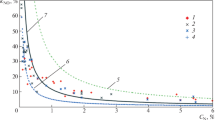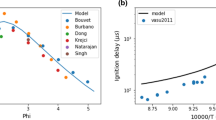Abstract
An experimental and numerical study of the NO x formation and reduction process in a designed coal combustion furnace under both traditional air atmosphere and O2/CO2 atmosphere was conducted, in an attempt to explore the chemistry mechanism of the experimentally observed NO x suppression under high CO2 concentration atmospheres. A simplified’ chemically oriented’ approach, computational fluid dynamics (CFD)-chemical kinetics modeling method, was validated and used to model the experimental process. The high CO2 concentration’s chemical effect on NO reduction has been studied, and the differences in NO x reaction behaviors between O2/CO2 atmosphere and air atmosphere were analyzed by detailed chemical kinetic model. On the basis of investigations through elementary chemical reactions, it can be concluded that high CO2 concentration plays an important role on NO x conversion process during oxy-fuel combustion. Moreover, the dominant reaction steps and the most important reactions for NO conversion under different atmospheres were discussed. Under O2/CO2 atmosphere, the main active sequence for NO reaction includes: NO→N→N2, and the main active path for NO reaction under air atmosphere is through N2→N→NO.
Similar content being viewed by others
References
Normann F, Andersson K, Leckner B, et al. Emission control of nitrogen oxides in the oxy-fuel process. Prog Energy Combust Sci, 2009, 35(5): 385–397
Normann F, Andersson K, Leckner B, et al. High-temperature reduction of nitrogen oxides in oxy-fuel combustion. Fuel, 2008, 87: 3579–3585
Buhre B, Elliott L, Sheng C, et al. Oxy-fuel combustion technology for coal-fired power generation. Prog Energy Combust Sci, 2005, 31(4): 283–307
Andersson K, Normann F, Johnsson F, et al. NO emission during oxy-fuel combustion of lignite. Ind Eng Chem Res, 2008, 47: 1835–1845
Okazaki K, Ando T. NOx reduction mechanism in coal combustion with recycled CO2. Energy, 1997, 22(2/3): 207–215
Liu H, Zailani R, Gibbs B. Comparisons of pulverized coal combustion in air and in mixtures of O2/CO2. Fuel, 2005, 84: 833–840
Liu H, Okazaki K. Simultaneous easy CO2 recovery and drastic reduction of SOx and NOx in O2/CO2 coal combustion with heat recirculation. Fuel, 2003, 82: 1427–1436
Lee C, Lee S, Han J, et al. Numerical study on effect of CO2 addition in flame structure and NOx formation of CH4-air counterflow diffusion flames. Int J Energy Res, 2001, 25: 343–354
Feng B, Ando T, Okazaki K. NO destruction and regeneration in CO2 enriched CH4 flame (A fundamental study on CO2 recycled coal combustion). JSME Int J Ser B, 1998, 41: 959–965
Ouimette P, Seers P. NOx emission characteristics of partially premixed laminar flames of H2/CO/CO2 mixtures. Int J Hydrogen Energy, 2009, 34: 9603–9610
Liu F, Guo H, Smallwood G, et al. The chemical effects of carbon dioxide as an additive in an ethylene diffusion flame: Implications for soot and NOx formation. Combust Flame, 2001, 125: 778–787
Park J, Lee K, Lee K, NO emission characteristics in counterflow diffusion flame of blended fuel of H2/CO2/Ar. Int J Energy Res, 2002, 26: 229–243
Park J, Park J, Kim H, et al. NO Emission behavior in oxy-fuel combustion recirculated with carbon dioxide. Energy Fuels, 2007, 21: 121–129
Glarborg P, Bentzen L. Chemical effects of a high CO2 concentration in oxy-fuel combustion of methane. Energy Fuels, 2008, 22: 291–296
Zhao R, Liu H, Hu H, et al. Homogeneous reaction mechanism research on NO in CH4 flame under O2/CO2 atmosphere (in Chinese). Proc CSEE, 2009, 29(20): 52–59
Kumar M, Sahu S. Study on the Effect of the operating condition on a pulverized coal-fired furnace using computational fluid dynamics commercial code. Energy Fuels, 2007, 21: 3189–3193
Sarlej M, Petr P, Stehlik P. Low-NOx burner design evaluation by CFD. 17th European Symposium on Computer Aided process Engineering, Bucharest, 2007
Konnov A, Dyakov I. Nitrous oxide conversion in laminar premixed flames of CH4+O2+Ar. Proc Combust Inst, 2009, 32: 319–326
Knyazkov D, Shmakov A, Dyakov I, et al. Formation and destruction of nitric oxide in methane flames doped with NO at atmospheric pressure. Proc Combust Inst, 2009, 32: 327–334
Hwang C, Hyun S, Lee C. Effects of heat Loss on NOx emission in the postflame region of premixed CH4-air combustion. Energy Fuels, 2008, 22: 996–1003
Faravelli T, Bua L, Frassoldati A, et al. A new procedure for predicting NOx emissions from furnaces. Comput Chem Eng, 2001, 25: 613–618
Molina A, Murphy J, Winter F, et al. Pathways for conversion of char nitrogen to nitric oxide during pulverized coal combustion. Combust Flame, 2009, 156: 574–587
National Institute of Standards and Technology, NIST Chemical Kinetics Database. Version 7.0, [OL], [2009-06-21]. http://kinetics.nist.gov
Pisupati S, Bhalla S. Numerical modeling of NOx reduction using pyrolysis products from biomass-based materials. Biomass Bioenergy, 2008, 32(2): 146–154
Zhao R, Liu H, Hu H, et al. Flame characteristics of C2H4 flame under O2/CO2 atmosphere. Sino-Australia Sympoisum on Advanced Coal and Biomass Utilization Technologies, wuhan, 2009
Zhao R, Liu H, Hu H, et al. A fundamental research on combustion chemical kinetic model’s precision property. Sci China Tech Sci, 2010, 53(8)}: 2222–22
Hu Y, Naito S, Kobayashi N, et al. CO2, NOx and SO2 emissions from the combustion of coal with high oxygen concentration gases. Fuel, 2000, 79: 1925–1932
Author information
Authors and Affiliations
Corresponding author
Rights and permissions
About this article
Cite this article
Zhao, R., Liu, H., Hu, H. et al. Experimental and modeling study of NO emission under high CO2 concentration. Sci. China Technol. Sci. 53, 3275–3283 (2010). https://doi.org/10.1007/s11431-010-4080-7
Received:
Accepted:
Published:
Issue Date:
DOI: https://doi.org/10.1007/s11431-010-4080-7




